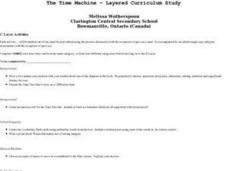Curated OER
Suspended Particulates lab
Students observe differences between suspended particulates and a solution, and classify common atmospheric gases and particulates. They explain what they think the word suspended means. Students observe the differences between what...
Curated OER
Find the Minerals
Learners read "A Minerals Story" while circling the words in the story that represent minerals. They find the words amber, gold, Feldspar, Galena, Copper, tin, gold, silver, iron, Quartz.
Curated OER
Relief Maps
Students study geographical maps and their functions. In this geography lesson students work in groups to build a map to scale.
Curated OER
Students Speak Up
Students share the ways they use technology at school and at home. In groups, they discuss how their study of math, science and technology is helping to prepare them for future jobs. They share their findings with the class and develop...
Curated OER
Suck It Up
Students investigate the "wicking capacity " of fabric; that is how well various fabrics draw water "perspiration" away from the body and let it vent to the outside. They brainstorm possible protocols to measure, tabulate and analyze the...
Curated OER
Scouting for Circuits
Fifth graders investigate electricity and how it used in a circuit to be useful energy. They also use this investigation in order to understand how energy can change forms and still be considered useful if put into the right form.
Curated OER
The Time Machine - Layered Curriculum Study
Students complete three activities of their choice from a given list surrounding their study of H.G. Wells' novel, The Time Machine. They choose activities from each of the seven learning styles.
Curated OER
Communications Technologies
Students explore the examples of innovative technology found on the AT&T Labs Technology Showcase Demos website. They look at communciation patterns. They write in their science journal the problem it is intended to solve and a...
Curated OER
Materials Engineering: Designing Walls
Students discover how the matierals in the earth can be used to make walls and buildings. They examine the Great Wall of China and its engineering. They complete the unit by creating their own wall from a design they drew.
Curated OER
Problem-Based Research Lesson: Wilderness Issues
Students read and discuss articles relating to the theme "How should we deal with the growth of towns and human populations into wilderness areas?" Based on the class brainstorm, each student generates a research topic. They are grouped...
Curated OER
The Next Dimension
Students explore the three dimensional Cartesian coordinate system and discuss how it is important for structural engineers in order to be able to describe locations in space to fellow engineers. They participate in a hands-on activity...
Curated OER
Homology
Students investigate the concept of homology. They are particularly interested in finding information about developmental homology. Students design a new animal correcting obvious mistakes on a worksheet provided by the teacher. They...
Curated OER
Falcon KWL Chart
Students create KWL charts about falcons. They write what they know about falcons and what they want to know about them. They read for information on falcons and complete the last column of their chart with the information they...
Curated OER
Worms in a Bottle
Students gain a better understanding of the worm and its role in the recycling of organic materials into simpler forms by constructing worm bottles and observing for 60 to 90 days.
Curated OER
Properties of Magnets
High schoolers determine the physical properties of magnets. They analyze the size, number of poles and strength of the magnets. They make observations of what happens to magnets when they are placed next to each other.
Curated OER
Chlorine-Bleached Paper
Young scholars analyze the effects of pollution and other types of ecosystem devasation caused by chlorine. They examine alternative technologies that allow for the bleaching of paper without using chlorine. They discover what they can...
Curated OER
Wacky Water Critters
Students recognize the biodiversity that exists in a wetland ecosystem. They identify individual wetland organisms. Students define, identify, and comprehend the importance of adaptations. They describe the process of metamorphosis.
Curated OER
Plotting a Magnetic Field
Young scholars experiment with a set of materials. They plot the magnetic field that arises from a regular bar magnet. They discover how a magnet affects a compass.
Curated OER
This is Your Rock, This is My Rock
Fourth graders review the types of rocks and minerals they see in photographs. Individually, they are shown a sample of rocks or minerals and classify them based on their characteristics. They give their observations to another...
Curated OER
A Seed Grows
Second graders begin the lesson by planting their own bean seed. Individually, they make predictions about how many leaves and roots their plant might grow and each day record their observations. They graph the results of the length of...
Curated OER
Get the Dirt
Students investigate a variety of soil samples placed in cold water jars. Layers of soil are examined for the difference between organic matter and rock fragments.
Curated OER
Cloud Databases
Young scholars complete a unit on clouds and a report about one type of cloud. They collect data through observation about different types of cloud cover and then create a spreadsheet to reflect their observations over a 2 week period.
Curated OER
Tagging Race
Students examine and identify plant parts to recognize specific weeds, identify three different weeds, discern differences in weeds quickly, evaluate classmates' weed recognition, and discuss what strategies they used to identify weeds.

























